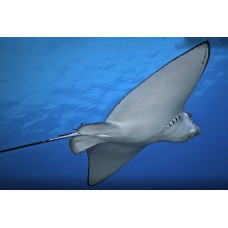Latin name
Aetobatus ocellatus
Other name
Whitespotted eagle ray
Identification
Compared to A. narinari, A. ocellatus has a longer tail (mean total length 281 mm vs. 263% of total body length) and a longer striae spine (mean length 9.7 mm vs. 8.9% of total body length). Dental plates are arranged in a single row, chevron-shaped on the mandible. Total vertebral midpoint 99-101, including synarcual.
Features of fish fins
Pectoral fin radii about 102-116, excluding the anterior pectoral radii in front of the eyes.
Fish colouring
The background coloration of the dorsal surface of A. ocellatus is dark greenish/grayish to almost blackish, while in A. narinari it is much paler, from medium yellowish to brownish.
Distribution
Indo-Pacific: East Africa, including the Red Sea to Hawaii and French Polynesia.
Habitat
Tropical marine brackish benthopelagic species. Depth range from 1 to 100 m, usually 20-25 m.
Size
Maximum length 300 cm, total length 180 cm. Maximum declared weight 200 kg.
Behavior
Occurs in coastal waters, including estuarine habitats. The ocellated ray's foraging range is based on anthropogenic noise, and populations are structured according to ontogenetic stages.
Food and feeding habits
They feed mainly on snails, mussels, crustaceans, worms, octopus and fish.
Reproduction
Ocellated eagle rays exhibit egg-laying ability, as the embryos are initially nourished by the egg yolk and then receive additional nutrients from the mother through indirect absorption of enriched uterine fluid. The gestation period lasts over 12 months and only a few young are born.
Fishing
Commonly caught in bottom trawl, coastal gillnet and to a lesser extent bottom longline fisheries.
Relationship with a person
The tail is used for decorative purposes. The flesh is edible. Traumatogenic.
| Classification | |
| Phylum | Chordata |
| Class | Chondrichthyes |
| Squad | Myliobatiformes |
| Family | Aetobatidae |
| Genus | Aetobatus |
| Species | A. ocellatus |
| Features | |
| Conservation status | Endangered |
| Habitat | Pelagic |
| Life span, years | No information |
| Maximum body weight, kg | 200 |
| Maximum length, cm | 300 |
| Sailing speed, m/s | No information |
| Threat to people | Edible |
| Way of eating | Predator |
Ocellated eagle ray
Tags: ocellated eagle ray




